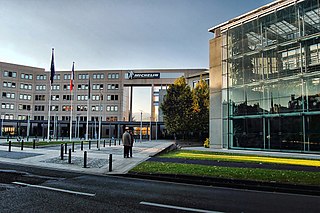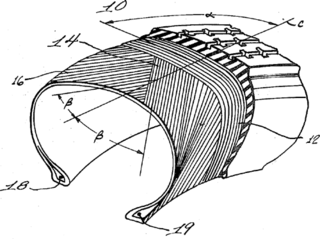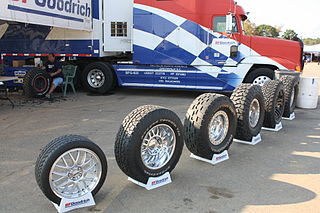Related Research Articles

A tire or tyre is a ring-shaped component that surrounds a wheel's rim to transfer a vehicle's load from the axle through the wheel to the ground and to provide traction on the surface over which the wheel travels. Most tires, such as those for automobiles and bicycles, are pneumatically inflated structures, which also provide a flexible cushion that absorbs shock as the tire rolls over rough features on the surface. Tires provide a footprint, called a contact patch, that is designed to match the weight of the vehicle with the bearing strength of the surface that it rolls over by providing a bearing pressure that will not deform the surface excessively.

Michelin is a French multinational tyre manufacturing company based in Clermont-Ferrand in the Auvergne-Rhône-Alpes région of France. It is the second largest tyre manufacturer in the world behind Bridgestone and larger than both Goodyear and Continental. In addition to the Michelin brand, it also owns the Kléber tyres company, Uniroyal-Goodrich Tire Company, SASCAR, Bookatable and Camso brands. Michelin is also notable for its Red and Green travel guides, its roadmaps, the Michelin stars that the Red Guide awards to restaurants for their cooking, and for its company mascot Bibendum, colloquially known as the Michelin Man, who is a humanoid consisting of tyres.

The Goodyear Tire & Rubber Company is an American multinational tire manufacturing company founded in 1898 by Frank Seiberling and based in Akron, Ohio. Goodyear manufactures tires for passenger vehicles, aviation, commercial trucks, military and police vehicles, motorcycles, RVs, race cars, and heavy off-road machinery. It also makes bicycle tires, having returned from a break in production between 1976 and 2015. As of 2017, Goodyear is one of the top five tire manufacturers along with Bridgestone (Japan), Michelin (France), Continental (Germany) and MRF (India).

August Schrader (1807–1894) was a German-American inventor and mechanic. He is known for inventing the Schrader valve.

The Tweel is an airless tire design developed by the French tire company Michelin. Its significant advantage over pneumatic tires is that the Tweel does not use a bladder full of compressed air, and therefore cannot burst, leak pressure, or become flat. Instead, the Tweel's hub is connected to the rim via flexible polyurethane spokes which fulfil the shock-absorbing role provided by the compressed air in a traditional tire.

A radial tire is a particular design of vehicular tire. In this design, the cord plies are arranged at 90 degrees to the direction of travel, or radially. Radial tire construction climbed to 100% market share in North America following Consumer Reports finding the superiority of the radial design in 1968, and were standard by 1976.

BFGoodrich is an American tire company. Originally part of the industrial conglomerate Goodrich Corporation, it was acquired in 1990 by the French tire maker Michelin. BFGoodrich was the first American tire manufacturer to make radial tires. It made tires for the then new Winton car from Winton Motor Carriage Company.

A run-flat tire is a pneumatic vehicle tire designed to resist the effects of deflation when punctured, allowing the vehicle to continue to be driven at reduced speeds for limited distances. First developed by tire manufacturer Michelin in the 1930s, run-flat tires were introduced to the public market in the 1980s. They have increased in popularity over time.

Charles J. Pilliod Jr. was an American business executive and diplomat. He was ambassador to Mexico from 1986 to 1989.
The Tire Society is a professional body, specifically an engineering society, whose mission is to increase and disseminate knowledge as it pertains to the science and technology of tires. It hosts a two-day Meeting and Conference every year. In addition, it publishes a peer reviewed technical journal, Tire Science and Technology. The Tire Society was founded on 24 March 1980.

Airless tires, non-pneumatic tires (NPT), or flat-free tires are tires that are not supported by air pressure. They can be used on small vehicles such as ride-on lawn mowers and motorized golf carts. They also are used on heavy equipment required to operate on sites where risk of tire punctures is high. Tires composed of closed-cell polyurethane foam are also made for bicycles and wheelchairs.

A bicycle tire is a tire that fits on the wheel of a bicycle or similar vehicle. These tires may also be used on tricycles, wheelchairs, and handcycles, frequently for racing. Bicycle tires provide an important source of suspension, generate the lateral forces necessary for balancing and turning, and generate the longitudinal forces necessary for propulsion and braking. Although the use of a pneumatic tire greatly reduces rolling resistance compared to the use of a rigid wheel or solid tire, the tires are still typically, the second largest source, after wind resistance, of power consumption on a level road. The modern detachable pneumatic bicycle tire contributed to the popularity and eventual dominance of the safety bicycle.

The following outline is provided as an overview of and topical guide to tires:

The Charles Goodyear Medal is the highest honor conferred by the American Chemical Society, Rubber Division. Established in 1941, the award is named after Charles Goodyear, the discoverer of vulcanization, and consists of a gold medal, a framed certificate and prize money. The medal honors individuals for "outstanding invention, innovation, or development which has resulted in a significant change or contribution to the nature of the rubber industry". Awardees give a lecture at an ACS Rubber Division meeting, and publish a review of their work in the society's scientific journal Rubber Chemistry and Technology.
The Melvin Mooney Distinguished Technology Award is a professional award conferred by the American Chemical Society, Rubber Division. Established in 1983, the award is named after Melvin Mooney, developer of the Mooney viscometer and of the Mooney-Rivlin hyperelastic law. The award consists of an engraved plaque and prize money. The medal honors individuals "who have exhibited exceptional technical competency by making significant and repeated contributions to rubber science and technology".
The purpose of the Sparks–Thomas Award, given by the American Chemical Society, Rubber Division, is to recognize and encourage outstanding contributions and innovations in the field of elastomers by younger scientists, technologists, and engineers. The award is named for Exxon scientists William J. Sparks and Robert M. Thomas, co-inventors of Butyl rubber.

Paul W. Litchfield was an American inventor, industrialist, and author. He served as President, Chairman, and the first CEO of the Goodyear Tire & Rubber Company and the founder of the town of Litchfield Park, Arizona and the city of Goodyear, Arizona. Among his many accomplishments as chairman was the establishment of a research and development department that produced the first practical airplane tire, long-haul conveyor belts, hydraulic disc brakes for airplanes, the first pneumatic truck tire, and a bullet-sealing fuel tank for military airplanes. Litchfield was also the author of books on air power, trucks, employee relations, and business.
Timothy B. Rhyne is a retired Michelin Research Fellow and co-inventor of the Tweel.
Shingo Futamura is a rubber industry materials scientist noted for his concept of the deformation index.
Howard A. Colvin is an organic chemist and consultant to the tire and rubber industries noted for developments in rubber chemicals and polymers, and for his DOE-funded work on using guayule rubber in tires.
References
- ↑ "TWO MICHELIN RETIREES RECOGNIZED FOR INNOVATIVE CONTRIBUTIONS TO INDUSTRY". MichelinMedia.com. Michelin. Retrieved 3 July 2022.
- ↑ Bell, Rudolph (20 November 2014). "Michelin executive: Tweel not ready for passenger car market". Greenville News. Retrieved 2 August 2022.
- ↑ Meyer, Bruce (18 October 2018). "Long development journey pays off for Tweel, Michelin". Tire Business. Crain. Retrieved 5 July 2022.
- ↑ Rhyne, T.B.; Cron, S.M. (1 September 2006). "Development of a Non-Pneumatic Wheel". Tire Science and Technology. 34 (3): 150–169. doi:10.2346/1.2345642 . Retrieved 29 August 2022.
- ↑ Beaven, Erin Putsay (12 September 2018). "Michelin Tweel designer Steve Cron honored at ITEC". Rubber and Plastics News. Crain. Retrieved 5 July 2022.
- ↑ "Tweel inventors named co-recipients of Charles Goodyear Medal". Tire Business. Crain. 6 October 2021. Retrieved 5 July 2022.
- ↑ Eddy, J.; Mars, W. V. "ORAL HISTORY INTERVIEWS - 2022 Charles Goodyear Medalists - Steve Cron & Tim Rhyne". rubber.org. ACS Rubber Division. Retrieved 28 December 2022.